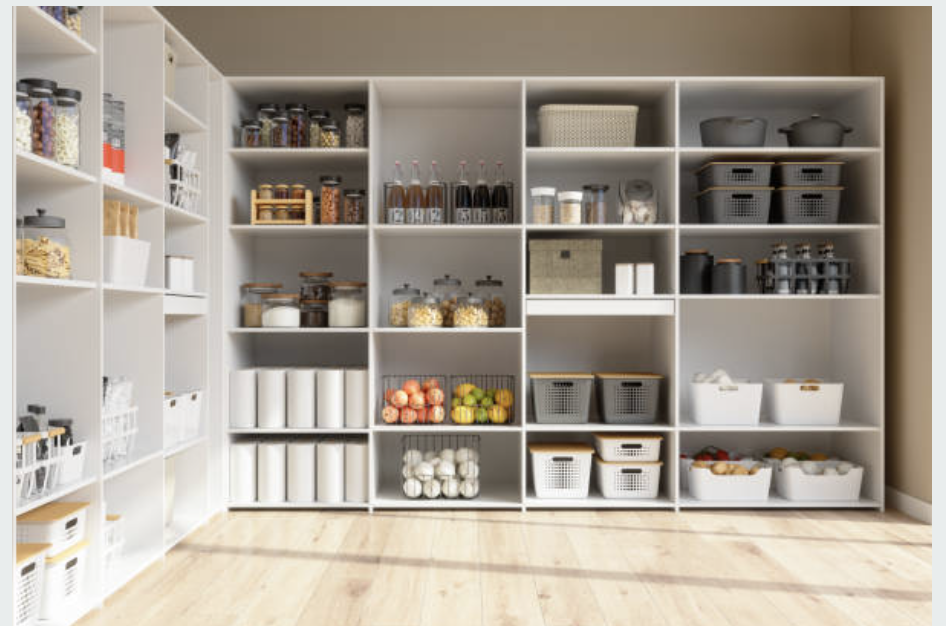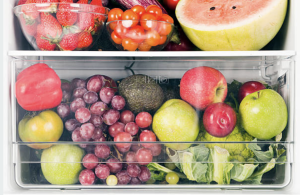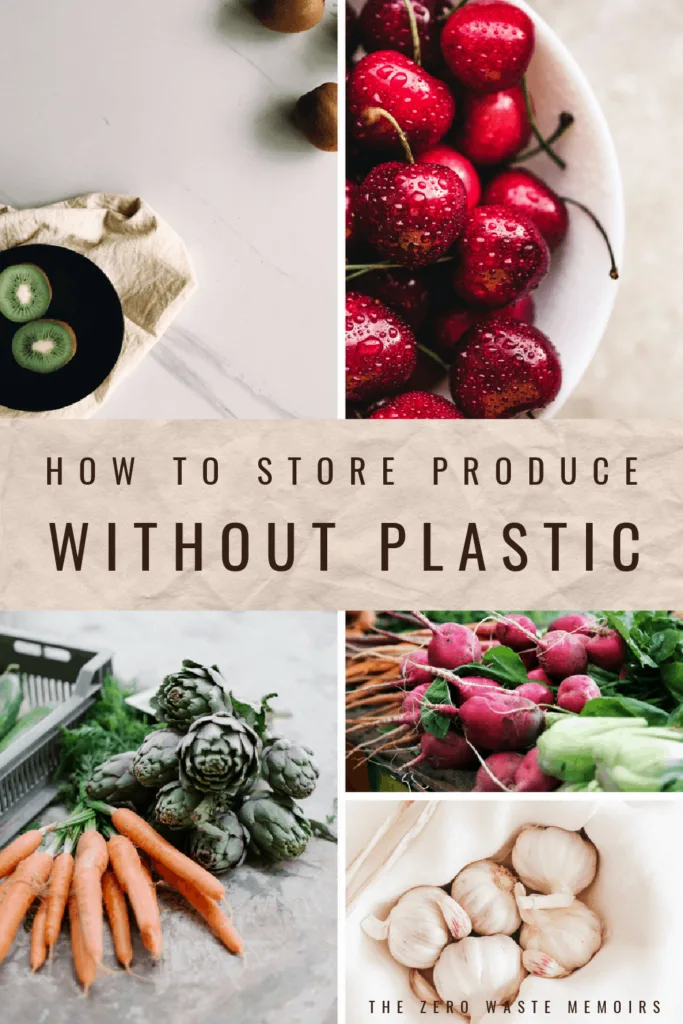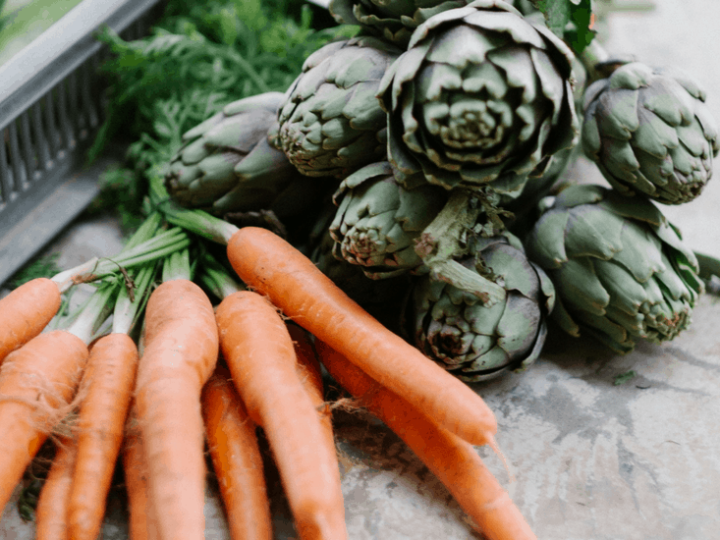Taking reusable, cloth bags to the store is a wonderful way to avoid sending plastic to the landfill. But what about when you get all that delicious food home? How do you keep it from spoiling without plastic?
Today, we’re tackling zero waste food storage – something I’ve been learning a lot about this summer!
I have a tendency to get a little “overzealous” at the farmer’s market (I mean, how can you resist all that organic goodness?!), leaving me to track down lots of tricky ways to keep my produce from going bad before I can use it all.
So far, I’ve been able to store all of our fruit and vegetables without any plastics. In fact, most of my produce is staying crisp and fresh for weeks!
How do I do it? Let’s dig in!
This article may contain compensated/affiliate links. See our full disclosure here.
Storing Vegetables Without Plastic

Leafy Greens
Leafy greens are known for their propensity to wilt or brown quickly. To keep your greens from spoiling too soon, first remove any tight bands or ties, then rinse and dry fully (these should not stay wet!) before wrapping loosely in a dry tea towel and placing uncrowded in the fridge.
Kale, a hardier green, will stay crisp and full when placed in a cup of water like a bouquet in the fridge.
Main Types: Arugula, cabbage, dandelion greens, mustard greens, watercress, spinach, lettuce
Bulb Vegetables
Bulb vegetables should always be stored in a cool, dark, dry place with good air circulation (a.k.a. a cellar or cool pantry). I’ve found success storing my bulb vegetables together with my tubers in a thick paper bag or wicker basket, then in my basement closet. A dark corner of the kitchen pantry should work too!
Main Types: Shallots, scallions, onions
Tubers
You should store your tubers just like your bulb vegetables (see above), in a cool, dark location that has good air flow. What you’re trying to avoid is your potatoes getting too much sun and greening or growing “eyes.” That’s no good!
Main Types: Sweet potatoes, yams, potatoes
Fruit Vegetables
Yes, fruit vegetables – it’s a thing. Think colorful, fleshy vegetables with soft insides! Veggies like this have a greater tendency than others to mold, thanks to their high moisture content. Only wash these vegetables right before you’re ready to eat them, as wetness will decrease your storage time.
I recommend placing these vegetables loose in the crisper if it’ll be a while before you use them. However, they can also be left on the counter for a few days without spoiling.
Main Types: Bell peppers, cucumber, zucchini, okra, squash, eggplant
Inflorescents & Mushrooms
Inflorescent vegetables like broccoli or cauliflower should be put in an open container or wrapped with a damp towel then placed in the fridge. However, they will likely have the best flavor if used the day of!
Mushrooms, on the other hand, should be stored in a paper bag in the fridge (I’ve recently transitioned to a paperless kitchen – so I’ve been using cloth produce bags instead). Bonus tip: if they dry out before you use them, you can reconstitute with water. They’ll perk right up!
Main Types: Artichoke, broccoli, cauliflower, mushrooms of all types
Root Vegetables
Beets, carrots, and the like, tend to wilt before they mold. No one wants a soggy carrot! To store properly, cut the tops off (leaving any top on root vegetables draws moisture away from the root, making them lose firmness) and then place in an open container with a moist towel on top, or dunk in cold water every few days to rehydrate.
Main Types: Beets, carrots, radish, turnips, rutabaga
Store Fruit Without Plastic

Stone Fruits
Stone fruit (a.k.a. fruit with a soft skin and pit inside) usually come with the summer heat. Apricots, plums, peaches, and avocado should be kept in a brown paper bag on the counter until ripe, then placed in the fridge when at their peak. Eat quickly afterwards!
Cherries and grapes on the other hand should be stored in an airtight container without any moisture. You don’t want these to mold on you!
Main Types: Avocado, plum, apricot, peach, cherrie, mango, grapes
Soft Fleshy Fruits
Berries (often called fleshy fruits) are extremely fragile. When storing, do not stack them high but lay them out in a single layer if possible. Doing this will keep your berries from getting mushy or being crushed during storage. Eat soon after buying!
Main Types: Strawberries, blueberries, blackberries
Citrus Fruits
Citrus fruits should always be stored in a cool place with good airflow (never in a container). They will stay steadily ripe for a while on the counter, as their protective outer rind keeps them from going bad too quickly.
Use lemons often in your cooking? Make sure they never go in the fridge! This will help the lemons retain their strong, rich flavor.
Main Types: Oranges, lemons, limes, tangerines, grapefruit
Pommes
Apples can be stored on a cool counter or shelf for up to two weeks. For longer storage, place them in an open cardboard box in the fridge so they stay crisp. Pears, on the other hand, should be ripened in a paper bag on the counter, then put in the fridge at their peak. Don’t let these go too long!
Main Types: Apples, pears, quince
Melons
Melons should be stored uncut on the counter and out of the sun. Once cut, simply put the slices in a container with a dry tea towel. This will soak up any leaking moisture and prevent the melon from getting too soggy. Eat quickly after cutting!
Main Types: Watermelon, casaba, honeydew, cantaloupe
Pin this for later!


